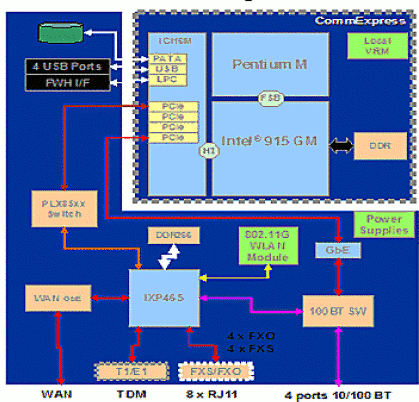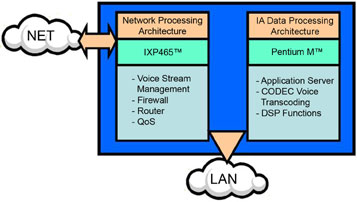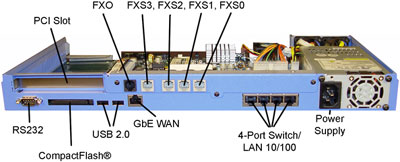Dual-processor Linux appliance targets convergent apps
Sep 13, 2006 — by LinuxDevices Staff — from the LinuxDevices Archive — views Win Enterprises is sampling an inexpensive Linux-based hardware appliance aimed at IP PBXs (Internet protocol private branch exchanges), VoIP (voice-over-IP) routers, and other “converged” applications. The Converged Application Platform (CAP) is based on an Intel reference design that Win Enterprises helped develop, it says.
Win Enterprises is sampling an inexpensive Linux-based hardware appliance aimed at IP PBXs (Internet protocol private branch exchanges), VoIP (voice-over-IP) routers, and other “converged” applications. The Converged Application Platform (CAP) is based on an Intel reference design that Win Enterprises helped develop, it says.
(Click for slightly larger view of Intel CAP design)
Win says the CAP will help equipment manufacturers, integrators, and resellers deliver next generation converged applications quickly and inexpensively. Potential applications listed by the company include Ethernet switches, router/firewall/VPNs, QoS (quality of service) devices, WAN (wide area network) access devices, WiFi access points, analog telephone adapters, and application servers.
The CAP is based on a low power Intel Pentium M processor, along with an Intel 915GM Express chipset. It also features a data-plane processing system based on an Intel IXP465 NPU (network processing unit).

CAP architecture
(Source: Win Enterprises)
The PC-compatible computer subsystem — that is, the Pentium M and 915GM chipset — is supported under both Linux and Windows. The NPU, meanwhile, is supported under Linux, only. The NPU can be used to manage IP and LAN traffic, “buffering traffic for transcoding by the Pentium M,” Win says.

Suggested CAP division of processor labor
(Source: Win Enterprises)
The CAP offers a wealth of I/O suitable for connection to analog and digital communication networks of various sorts.

CAP rear-panel I/O
Touted CAP specs and features include:
- Processor
- Intel Pentium M processor with 400/533 MHz FSB
- Chipset
- Intel 915GM Express + ICH6-M
- I/O Chipset
- Winbond W83627HF-W
- Network Processor
- Intel IXP46x at 667 MHz with 32MB Flash ROM and 128MB System RAM
- IA Memory Up to 1GB DDR2 RAM
- I/O
- IA Serial Port One DB-9 Serial Port with support for hardware redirection
- One Serial Port via header port
- IA USB Supports Four USB 2.0 Ports (2x External, 2x Internal via header)
- IA GPIO Supports five software-definable LEDs
- Networking
- One 10/100 WAN interface
- Integrated 6 port Gigabit non-managed switch providing 4 external Gigabit
LAN ports
- Storage
- One SATA interface for a 2.5″ HDD
- One 50-pin CompactFlash Socket
- Interfaces/expandability
- One 32-bit/33 MHz rt angle PCI slot
- One MiniPCI slot
- HSS Two HSS (high speed serial) interfaces for adding one T1/E1/J1 module
and one FXO/4 port FXS module or ADSL interface
- Mechanical and environmental
- Pentium 4 style ATX Power Supply
- 1U form factor
- Operating Temperature: 32 to 122 degrees F (0 to 50 degrees C)
- 17 x 9.25 x 1.75 inches (43.18 x 23.5 x 4.45 cm)
- Software support
- The IA is supported under Linux or Windows
- The IXP is supported under Linux
On the software side, the CAP supports software options that include:
- Intel NetStructure Host Media Processing (HMP)
- Intoto network security software
- Asterisk open source IP PBX
Win CEO/CTO Chiman Patel stated, “Intel worked closely with WIN Enterprises to develop the Intel reference design for Converged Application Platform for the Distributed Enterprise.”
Availability
The CAP is sampling now, with volume production expected in November, priced around $2,000, with quantity discounts available.
This article was originally published on LinuxDevices.com and has been donated to the open source community by QuinStreet Inc. Please visit LinuxToday.com for up-to-date news and articles about Linux and open source.